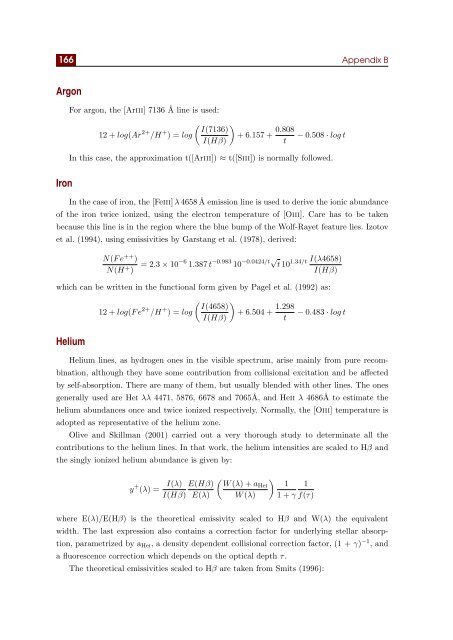A spatially resolved study of ionized regions in galaxies at different ...
A spatially resolved study of ionized regions in galaxies at different ...
A spatially resolved study of ionized regions in galaxies at different ...
Create successful ePaper yourself
Turn your PDF publications into a flip-book with our unique Google optimized e-Paper software.
166 Appendix B<br />
Argon<br />
For argon, the [Ariii] 7136 Å l<strong>in</strong>e is used:<br />
12 + log(Ar 2+ /H + ) = log<br />
( ) I(7136)<br />
+ 6.157 + 0.808 − 0.508 · log t<br />
I(Hβ)<br />
t<br />
In this case, the approxim<strong>at</strong>ion t([Ariii]) ≈ t([Siii]) is normally followed.<br />
Iron<br />
In the case <strong>of</strong> iron, the [Feiii] λ 4658 Å emission l<strong>in</strong>e is used to derive the ionic abundance<br />
<strong>of</strong> the iron twice <strong>ionized</strong>, us<strong>in</strong>g the electron temper<strong>at</strong>ure <strong>of</strong> [Oiii]. Care has to be taken<br />
because this l<strong>in</strong>e is <strong>in</strong> the region where the blue bump <strong>of</strong> the Wolf-Rayet fe<strong>at</strong>ure lies. Izotov<br />
et al. (1994), us<strong>in</strong>g emissivities by Garstang et al. (1978), derived:<br />
N(F e ++ )<br />
N(H + )<br />
= 2.3 × 10 −6 1.387 t −0.983 10 −0.0424/t√ 1.34/t I(λ4658)<br />
t 10<br />
I(Hβ)<br />
which can be written <strong>in</strong> the functional form given by Pagel et al. (1992) as:<br />
12 + log(F e 2+ /H + ) = log<br />
( ) I(4658)<br />
+ 6.504 + 1.298 − 0.483 · log t<br />
I(Hβ)<br />
t<br />
Helium<br />
Helium l<strong>in</strong>es, as hydrogen ones <strong>in</strong> the visible spectrum, arise ma<strong>in</strong>ly from pure recomb<strong>in</strong><strong>at</strong>ion,<br />
although they have some contribution from collisional excit<strong>at</strong>ion and be affected<br />
by self-absorption. There are many <strong>of</strong> them, but usually blended with other l<strong>in</strong>es. The ones<br />
generally used are Hei λλ 4471, 5876, 6678 and 7065Å, and Heii λ 4686Å to estim<strong>at</strong>e the<br />
helium abundances once and twice <strong>ionized</strong> respectively. Normally, the [Oiii] temper<strong>at</strong>ure is<br />
adopted as represent<strong>at</strong>ive <strong>of</strong> the helium zone.<br />
Olive and Skillman (2001) carried out a very thorough <strong>study</strong> to determ<strong>in</strong><strong>at</strong>e all the<br />
contributions to the helium l<strong>in</strong>es. In th<strong>at</strong> work, the helium <strong>in</strong>tensities are scaled to Hβ and<br />
the s<strong>in</strong>gly <strong>ionized</strong> helium abundance is given by:<br />
y + (λ) =<br />
I(λ) E(Hβ)<br />
I(Hβ) E(λ)<br />
( W (λ) + aHei<br />
W (λ)<br />
) 1 1<br />
1 + γ f(τ)<br />
where E(λ)/E(Hβ) is the theoretical emissivity scaled to Hβ and W(λ) the equivalent<br />
width. The last expression also conta<strong>in</strong>s a correction factor for underly<strong>in</strong>g stellar absorption,<br />
parametrized by a Hei , a density dependent collisional correction factor, (1 + γ) −1 , and<br />
a fluorescence correction which depends on the optical depth τ.<br />
The theoretical emissivities scaled to Hβ are taken from Smits (1996):

















